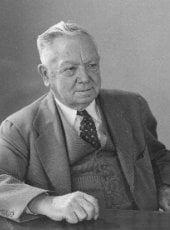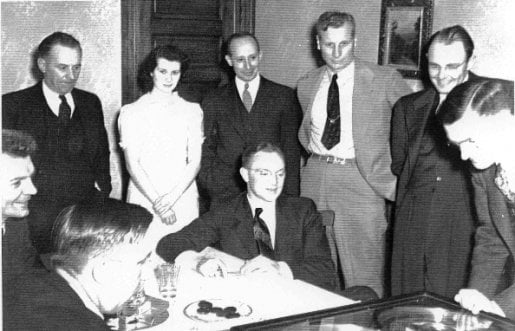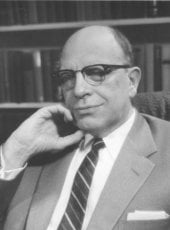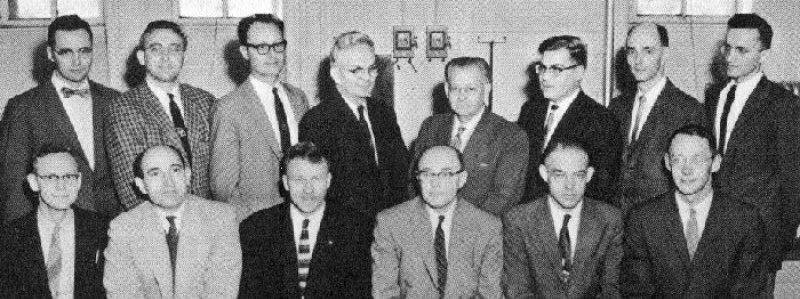Growing to become a University
Beginning in 1940, the curriculum in physics was gradually filled out to include the basic courses needed for a physics major, which first appeared in 1941 as an option under the BS in General Science.

In 1944 James Fisher Jr., having passed 70 years of age, retired from academic duties. Fisher remained active taking on several new non-teaching obligations, most notably an even more active role with the alumni association. Fisher remarked that now that he was retiring, he could enjoy “working only 12 hours a day instead of his usual 10.” Almost immediately after Fisher’s retirement, the math and physics faculty formally went their separate ways.
Fay Partlo and John Harrington, who had had parallel careers up to that point—both graduating from MCM, both receiving a Ph.M. degree from the University of Wisconsin, both hired as instructors at MCM in 1923 with every promotion entirely in sync.—served as the two separate department heads. Fisher’s retirement also left the Dean position open, which was also filled by Partlo. Harrington remained Head of Mathematics into the 1960’s.
Partlo, as did Fisher, served simultaneously as Department Head and Dean for the first few years. Partlo then gave up the Department Head position, to be taken up first by Jerry Service and then Tom Sermon. In doing so, it appears that Partlo became our first Dean who had no other administrative appointment (e.g. department head). Thus, quite literally, it ultimately took three new administrators to replace Fisher. While one should not diminish Fisher’s contributions, when interpreting this statement it must also be remembered, however, that MCMT had grown significantly. Also at this time one was not generally promoted to professor without an administrative appointment and there were several 20-year faculty who had been waiting in the wings for their chance.
The separation between being Professor and holding an administrative position is seen across the campus in the late 1940’s and demonstrated in Physics for the first time in 1949 with the promotion of Longacre and the return of Service from the Headship to faculty status. While there were at least two professors throughout most of the history of the department, one of them would have a significant administrative position outside of the department (i.e. McNair as President, Duggan as Registrar, Partlo as Dean of the College). Now it became acceptable to have additional professors in the department who did not also have an outside administrative position.

During the post World War II years the College’s total enrollment increased dramatically. The Sault Ste Marie campus of MCMT was opened in 1946, initially to provide the first two year’s worth of courses. Also in 1946, BS degrees offered by the department in Physics, Engineering Physics, and Geophysical Engineering first appear, with a curriculum expanded to match. By 1948 the total College enrollment had topped 2000. With this growth also came a flurry of new faculty hires.
Immediately after Math and Physics split, Physics was left with four faculty members: Partlo, Longacre, Sermon and Service, though Capt. Service was still on leave having been in the Navy Reserve when World War II started. By 1950 there were fourteen Physics faculty. In contrast to the hires of the 1920’s, of the ten new hires, only half had their BS degree from MCMT, seven of the ten had at least one degree from another institution, seven of them had a Master’s degree when hired (the majority of those were from the University of Michigan) and one more received it shortly thereafter. The only degree beyond the Master’s was Donald H. Baker’s Ed.D. from Michigan State. D. O. “Doc” Wyble, hired by this time, later earned his PhD (in 1957) after an absence from campus to serve in the Navy and pursue his studies.
During the 1950’s there was considerable growth on campus and an effort to formalize the graduate programs. Over a dozen new MS programs appeared across campus during this time including one in Engineering Physics and one in Physics. The latter was intended to rely heavily on a joint agreement with Argonne National Labs for research opportunities. The MS in Engineering Physics disappeared after 1960 and at the same time the Engineering Physics BS was renamed “Applied Physics.”1 A total of only about a half dozen students graduated with an Engineering Physics MS. The College’s graduate programs had been under a Director up until 1960 when the graduate school was formed and Physics Professor Don Yerg became the first Graduate School Dean.
At the Sault campus, Professor of Physics Harry Crawford was hired and named director in 1954. Shortly after that a number of the physics faculty from the Houghton campus moved to the Sault campus. Crawford was instrumental in building and developing the Sault campus until his retirement in 1965, preparing the Sault campus to formally break away to become Lake Superior State University.
A campus-wide rework of the entire curriculum is seen in the late 1950’s, just in time for the arrival of President Van Pelt. The old A, B, C course designations, with one to three digits, disappeared and were replaced with the two-letter, three-number scheme used until the change to semesters in 2000. The Physics course numbers began with “PH,” Math with “MA,” etc., the same as is done today. In the Physics curriculum, a number of “500-level” graduate courses were added in support of the new Master’s programs. The “C” Mechanics courses were given the “EM” designation and those courses were soon sent off to the newly created Engineering Mechanics department (later to be combined with Mechanical Engineering, ME, to form a combined ME-EM department).
During the 1950’s the instructional demands on the department grew steadily. The demands on the faculty’s time and the limited, aging space in Hubbell Hall left little room for any research activities. Despite the considerable growth in the number of faculty, the development of graduate degrees and talk of a more research active faculty, there was an average of under one scientific publication per year for the entire physics department. In fact, in 1959 the total externally funded research by the entire MCMT faculty was reported to be about $30,000.

Towards the end of the 1950’s it became clear that new space was necessary to handle the growth in the student population—all needing introductory physics and math courses. President Van Pelt made a new building to house Physics and Math, as well as a new library, a high priority. Due to tight state budgets, raising the funds was difficult but the new building for Physics and Math was finally started in 1962 and the new library in 1964, the last year of Van Pelt’s presidency. The library now bears his name. Both of the buildings would be on the South side of College avenue, along with the Memorial Union.
James Fisher still came into his office on a regular basis and was active in alumni affairs up until the summer of 1962, when he suffered a heart attack and passed away a few days later. This was during the final planning stages for the new building for Physics and Math. The ground breaking for the new building occurred in the Fall of 1962 and by December 1962 the MCMT Board of Control, based on recommendations from students and alumni, had decided that the new building should be named in Fisher’s honor. Fisher Hall was completed for the Fall of 1964 and the formal dedication on Oct 7, 1964, was quite a show. Photos, stories of the proceedings, and talk of the new modern building dominated the pages of the Daily Mining Gazette for several days.
During the late 50’s the interest in mining had been on the decline to the point that there was concern that even having the word “mining” in the College’s name could be a detriment. After considerable discussion, Van Pelt and the Board of Control settled on a new name: Michigan College of Science and Technology, MCST. Since the State constitution was being rewritten at the time, the new name was incorporated into it.2 Before the new laws took effect, the name was changed again to the current name: Michigan Technological University, MTU. An interesting bit of trivia is that for legal reasons3 the College is claimed to have had the name Michigan College of Science and Technology for the first hour of New Year’s Day, 1964, the effective date of the new constitution. The MTU name did not take effect until 1 am.
In 1964 the Physics department found itself in a new building at an institution with a new name, about to have a new President, Ray Smith, who had a new vision for the University. They also had a new department head, Dean Stebbins, who took over from Bill Longacre. Stebbins was the first external hire for department head since McNair in 1893 and also served as Dean of the Faculty (causing some confusion with his first name) and as Vice President for Academic Affairs (VPAA). For a time he would occupy all three jobs simultaneously.
- The removal of “Engineering” from the name of the programs was apparently due to issues related to accreditation.
- see article VIII, Sec. 4, of the Michigan Constitution.
- This supposedly arose since the new constitution had already been adopted and included the words “by whatever names such institutions may hereafter be known.” The simple solution was to allow the MCST name to take effect so that the MTU name could be considered a simple name change. Apparently 1 hour was considered sufficient for this purpose. At least it makes for a good story.
